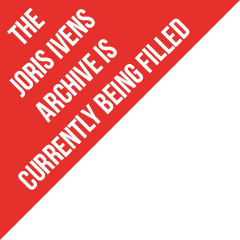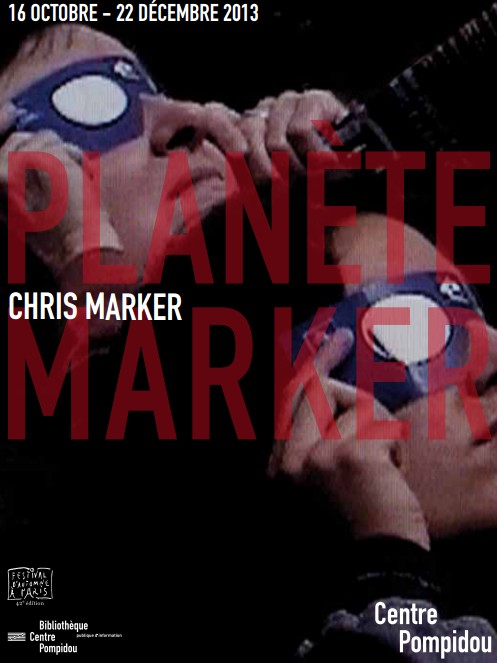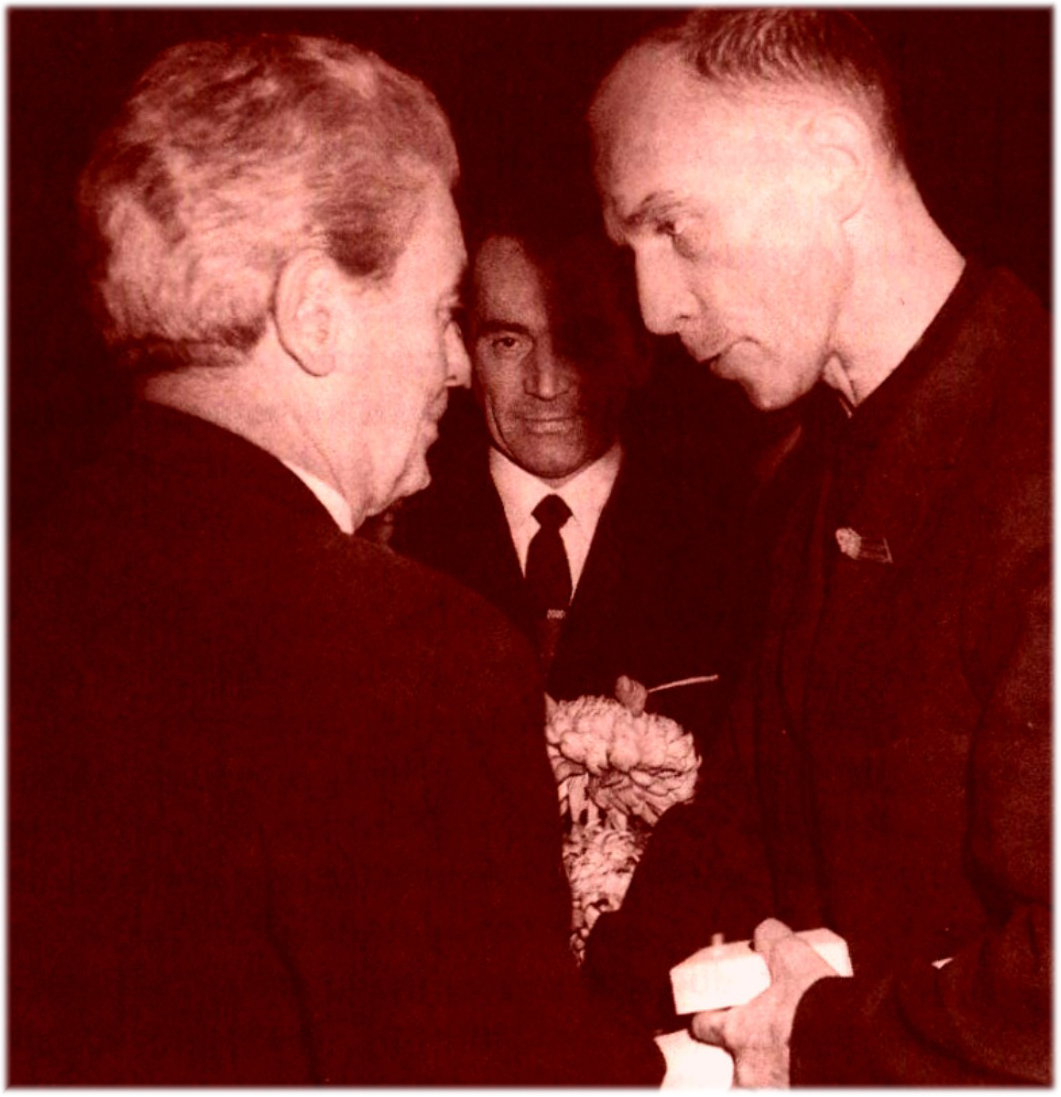


Centre Pompidou in Paris vertoont een hommage aan filmmaker Chris Marker (van 16 oktober tot 16 december). Niet alleen met films, maar ook met een expositie van installaties, foto`s, documenten en met vertoningen, waarmee zijn inspiratiebronnen, vriendschappen en ontmoetingen worden gepresenteerd. Chris Marker werkte met zijn vriend Joris Ivens samen aan diverse filmprojecten: …a Valparaiso, Rotterdam Europort, Le ciel, la terre enLoin de Vietnam. Op 23 november zal de gerestaureerde versie van Loin de Vietnam (Far from Vietnam, 1967) worden vertoond.

Joris Ivens en Chris Marker in Leipzig, 1963.
`There are `century-class men` and `world-class men` - and Chris Marker was one of them. He was born in 1921, shortly after the First World War, `the founding moment of the last century, and its source` (he devoted his 2005 video installation The Hollow Men to it), and was very much involved in the Second, starting off as a member of the Resistance, then enlisting in the American army. Chris Marker lived in a world haunted by the fear of a Third World War, which he looks forward to in his most famous film, La Jetée, the first film composed (almost) solely of still images, haunted by phantoms of the world of concentration camps.
Chris Marker was a photographer throughout his life, and started out as a poet, novelist, essayist, literary/ film critic and editor at the Éditions du Seuil, where he invented the `Petite Planète` illustrated critical guide collection. He became a film-maker in the early Fifties with a film on the Helsinki Olympic Games, and collaborated with Alain Resnais for Les statues meurent aussi, a documentary essay on Black Art and colonialism long banned by the censor. Marker went on to make at least fifty films in all formats: feature-length, short, very short, and very long. And under various pseudonyms, or more or less anonymously, he generously contributed to many other films by friends and colleagues. All his films have a constant political commitment in common, a tireless, encyclopaedic curiosity for all forms of reality and culture, and an unfailing love of animals, especially cats. He turned his cat, Guillaume-en-Égypte, into an avatar who served as his spokesman, from the creation of his CD-Rom Immemory, 1997-1998, right up to the virtual archipelago he later invented for himself in `Second Life`.
But above all, to construct his films, Chris Marker came up with a unique way of relating the texts he ceaselessly wrote with the images he collected throughout the world – both images shot from life and excerpts from multiple archives. André Bazin, in his commentary on Lettre de Sibérie (1957), called this `horizontal editing` in order to describe the way he felt Marker edited his images: not shot-by-shot so much as `laterally, in a way, to what is being said about them `. The result was an inseparable meld: a primordial condition for this form of subjective essay. Marker was one of the great inventors of this genre – perhaps the greatest, continually subjecting the documentary approach to the fictional part that enabled him to develop his thread, while always talking to the `other `– his virtual reader/viewer – as though to a fully alive being.
Two descriptions seem to truly pinpoint this singular identity called Chris Marker (originally Christian-François Bouche-Villeneuve). The first is so legendary that its precise reference is lost. It comes from Henri Michaux, the writer to whom Marker was probably the closest; in fact his work is sprinkled with signs that he borrowed from him in a more or less recognisable manner. Michaux was also the model for Marker`s legendary discretion, and his concern to preserve himself as much as was humanly possible from any kind of publicity, and any consent to the media society. Michaux said, `The Sorbonne should be pulled down and Chris Marker set up in its place.` The suggestion here is, for example, that L`Héritage de la chouette, Marker`s television series of thirteen 26-minute episodes on the culture of Ancient Greece, should feature on the curriculum of all French schools. The second description comes from Alain Resnais, in an interview in (almost) the first special issue of a review dedicated to Marker in 1963. Resnais attributed to a Chris Marker apparently little satisfied with the idea of the review the words he imagined he would use to evade any kind of obligation: `… I am a free man, and I only want to do what I like.` But, emphasising how much he felt his friend`s work should be studied, Resnais said at the end of the interview: `We talk about the Leonardo da Vinci method; perhaps we shall soon be talking about the Chris Marker method. I would even go as far as to say that Marker is superior to Leonardo, because Marker always follows everything he starts right through.`
This stresses the unique character as well as the importance of his work, which became evident very early on, and which went on developing according to an essentially exploratory curiosity, as history turned up yet another surprise. And he was always right up to date with the technological changes that could cause shifts in an endlessly reinvented relationship between words and images. With books albums, photos, films, videos, installations, CD-Roms and the Internet, Marker`s work continually explored every medium, inspiring an ever-increasing number of film directors and artists all over the world – up until his sudden death, barely a year ago, on the day he reached 91. So this is everything the `Planète Marker` event would like to celebrate, faithful to the spirit of the book collection through which he once helped to transform French publishing.`
Curator : DDC / Les cinémas, S. Pras, MnamCci / Nouveaux médias, C. Van Assche, BPI / Comprendre, A. Alliguié
Loin du Vietnam
(version restaurée)
Cinéma et Vidéo
23 novembre 2013, à 20h00
Cinéma 1 - Centre Pompidou, Paris
6€, 4€ T.R. et Abonnés Festival d`Automne, 2€ moins de 18 ans, L.P. Gratuit dans la limite des places réservées
Loin du Vietnam, de Chris Marker, Jean-Luc Godard, Joris Ivens, Alain Resnais, Claude Lelouch, William Klein…, France, 1967, 115’, coul., version restaurée
présenté par Michèle Ray-Gavras (participante)